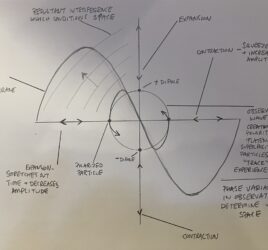
Infinity Physics – Interconnectedness
Infinity Physics continues to develop through awareness, insights and perceptual shifts which are redefining space, time, movement, and its relation to our consciousness. Following the string of data unfolding through Infinity Physics, interesting observations are being formed about forces, systems and the interconnectedness of all things. We are starting to understand how the seemingly sovereign state of entities reconciles with the budding data which leads us to understand that everything is unified into an indivisible whole.
Take gravity for example. Gravity is an interesting force. It has the strength to hold solar systems and whole galaxies together, yet it is so weak it cannot even pull a drop of dew from the top of a blade of grass to the ground. When dealing with quantum physics it is not even considered as it is in essence statistically irrelevant. Current theories of how gravity works involves the curvature of space around large objects creating “tracks” in which matter is pulled into and held. Infinity Physics is discovering more information on the nature of gravity and how it affects matter.
Infinity Physics defines space as the degree of polarization within any given system. At the contraction point, space has little polarization. As a system of space expands, it gains more polarity.
Time is defined as the flow of information through space. As time flows into space, it is stretched out in direct relation to the degree of increased polarization. It also is squeezed or compressed as polarization within the space of a system decreases.
We are also understanding that not only are space and time interconnected, they are in fact two sides of the same unified perception. The more time, the less space; the less space, the more time. We also are becoming aware that when we endeavor to explain space and time separately, they are in opposition to how we experience them, as we can only experience space and time together. So that when we speak of “more time”, we are not speaking of the experience of more time (minutes, hours, etc.), we are speaking of the rate, amplitude and frequency of information within the space of any given system.
Given this knowledge, we understand that in our sensory experience, all seemingly separate aspects are staged within different time frequencies. We must now understand that each system focuses a specific polarization of information (time). This information is made available within the system and stretched and contracted by the degree of its polarization (space). As the information is more or less polarized, it expresses itself within the boundaries of its own space/time. This means that as one unified frequency flows through space, it is stretched or contracted into multiple frequencies depending on the influence the system has on the frequency through its space/time makeup.
Let’s go back to gravity now that you understand some of the background.
Gravity is the focal point of a system of space and time. Let’s call it a time bubble. It is the observation vector for that system which polarizes information. Through the process for bidirectional expansion and contraction (time expanding as space contracts, space expending as time contracts), information is dispersed through the system.

Analogous to this system would be the dropping of a pebble in a body of water. The pebble creates a unified force (signal) which at the same time pushes water outward and pull water inward. If you look that the waves which emanate from the central point, they will be both higher and closer when closer to the center, and they will stretch out and become longer and more spread out the further they are from the center. The energy from the pebble is time. The waves in the water is space.
Let us look at how information is then perceived within this system. Let’s add a unified informational input, let us use the sun in this example. As we observe the system, we will see the sun reflecting off the peaks of the waves. The reflection of the suns on the peaks will look much different in the inner waves as compared to the outer waves. The reflection has more surface area on the perimeter, the waves are more gradual, and the peaks are not as sharp (stretched out). This results in those reflections being more fixed and less detailed than the shorter, faster waves with sharp peaks near the center of the system. The information being reflected closer to the center has more detail and is more dynamic as the next wave is closer and the changes in amplitude of the wave therefore more frequent than the perimeter waves.
In between the peaks (reflection of information into sensory reality) are the troughs. The troughs are analogous to space. This space is not empty, it is only the absence of reflection in the system. This absence of reflection in the system creates definition from one reflection to the next. The further the waves move from the center, the larger the toughs become as time is stretched through space. The peaks of course are analogous to mater, that which we perceive. The peaks are tension points in which the polarity of space creates the ideal condition for reflection of information for sensory observation.
This is gravity. Gravity becomes stronger as space is more polarized. This is why gravities effects at the large scale are enormous, while at the small scale, they are insignificant. There is no push – pull happening here. There is the crystallization of matter which occurs in the “goldy locks” space (the peak) in relations to the object it is being compared with (the central observation vector). Gravity is relative to what it is being compared to, as is everything determined in our sensory reality.
The tension points of gravity are of a high frequency near the center. Determined matter is difficult to materialize in a localized form within that gravitational space. This is the case on the quantum level. When we speak on the subatomic scale of electrons, we can only predict the potential of crystallization within the material realm. We call these electron fields, and the tension points “atomic orbitals”. Some systems are more complex than others and so we have many types of atomic orbitals.
So, on the subatomic scale, gravity still exists, however the polarization of space is insufficient to create localized matter. We may then state that the “outside” of the atom is the perimeter of the atomic system which does stretch time out enough, that the polarity of space in that region can create a fixed and localized material entity.
From that “maximum expansion point” information is collapsed back into the system informing time through the phase variance in the bidirectional flow of information.
However, we must understand that time does not stop flowing at the max expansion point, it only is the max expansion point of that particular system. In this respect, time continues past the max expansion point to inform a greater system in which the previous system is a part.
We can also look at larger systems in the same respect. If we look at the solar system, the sun being the observation vector of that system, we can see the tension points in space which create “goldy locks” (optimum) polarity for the crystallization of matter. These gravitational tension points become larger and further apart as we expand outward until the edge of the solar system (the max expansion point). Note that gravity is defined and measured by our definition of the system in which we observe. This is an important point and perhaps one which is difficult to accept from a scientific vantage point. Over and over again, we are seeing that our perception / observation is in direct relation to the laws of physics. This is also evidenced in quantum physics but not entirely understood or explored.
The greater the space between the tension points, the greater the impression of the effects of gravity. We must remember that the sun is not holding any of the planets there by some magical force, it only is the observation vector which provides time to the system within space. As the system is informed it creates tension points in which matter naturally settles into (or is manifest as sensory accessible information).
We must also understand that the information at the peak (displayed in sensory format) is also available within all other parts of the wave as “non-sensory” data. The seed and the flower are the same thing. They the same information, only separated through the flow of time and stretched by space.
It is also interesting to note that even the peaks close to the observation vector can be accessed through sensory means, however they are less localized and static. Observation of the greater frequencies of time within highly unpolarized space is possible. It is also interesting to note that as we change our observation vector to become smaller and smaller, we create new maximum expansion points, essentially creating new expressions of time (new matter). This system is inlayed in everything so we can say that everything is emanated from one unified entity being manipulated by space, time, and our observation of space/time systems.



